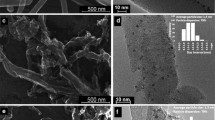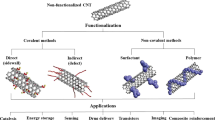Abstract
A fundamental understanding is developed for the chemical reaction mechanism that underlies platinum atomic layer deposition (ALD) on a carbon support, XC72R, for use as a fuel cell catalyst. Specifically, trimethyl(methylcyclopentadienyl)platinum(IV) (MeCpPtMe3) was fed as the 1st reactant for ALD on high surface area particles using a well-instrumented fluidized bed reactor equipped with an in-line mass spectrometer. The precursor’s organic ligands were removed by reaction with the 2nd reactant, either oxygen or hydrogen. These experiments were performed on both unmodified and functionalized XC72R. Carbon modification involved reflux with nitric acid, which oxygenated the XC72R. Platinum weight loading, average particle size, and particle dispersion depended on carbon treatment and on the reactant used for ligand removal (oxygen or hydrogen). Deposited platinum particle sizes ranged from 2.6 to 6.7 nm. Transmission electron microscopy, chemisorption, and diffuse reflectance infrared Fourier transform spectroscopy were used to characterize the Pt deposition and carbon support functionalization. More discrete and non-agglomerated platinum nanoparticles were produced using hydrogen, rather than oxygen, as a reactant and when deposition was conducted on functionalized, rather than unmodified, XC72R carbon. The platinum nanoparticles are stabilized by the underlying oxygen added during substrate functionalization and the avoidance of carbon substrate combustion when using hydrogen, instead of oxygen, as the 2nd reactant to remove residual ligands.












Similar content being viewed by others
Abbreviations
- PEM:
-
Proton exchange membrane
- ALD:
-
Atomic layer deposition
- MeCpPtMe3:
-
Trimethyl(methylcyclopentadienyl)platinum(IV)
- DRIFTS:
-
Diffuse reflectance infrared Fourier transform spectroscopy
- TEM:
-
Transmission electron microscope
References
Antoine O, Bultel Y, Durand R (2001) Oxygen reduction reaction kinetics and mechanism on platinum nanoparticles inside Nafion®. J Electroanal Chem 499:85–94. doi:10.1016/S0022-0728(00)00492-7
Christensen ST, Feng H, Libera JL, Guo N, Miller JT, Stair PC, Elam JW (2010) Supported Ru-Pt bimetallic nanoparticle catalysts prepared by atomic layer deposition. Nano Lett 10:3047–3051. doi:10.1021/nl101567m
Dameron AA et al (2012) Aligned carbon nanotube array functionalization for enhanced atomic layer deposition of platinum electrocatalysts. Appl Surf Sci 258:5212–5221. doi:10.1016/j.apsusc.2012.01.139
Debe MK (2012) Electrocatalyst approaches and challenges for automotive fuel cells. Nature 486:43–51
Edwards PP, Kuznetsov VL, David WIF, Brandon NP (2008) Hydrogen and fuel cells: towards a sustainable energy future. Energy Policy 36:4356–4362. doi:10.1016/j.enpol.2008.09.036
El-Hendawy A-NA (2003) Influence of HNO3 oxidation on the structure and adsorptive properties of corncob-based activated carbon. Carbon 41:713–722. doi:10.1016/S0008-6223(03)00029-0
Elliott SD (2010) Mechanism products, and growth rate of atomic layer deposition of noble metals. Langmuir 26:9179–9182. doi:10.1021/la101207y
Erkens IJM, Mackus AJM, Knoops HCM, Smits P, van de Ven THM, Roozeboom F, Kessels WMM (2012) Mass spectrometry study of the temperature dependence of Pt film growth by atomic layer deposition ECS journal of solid state. Sci Technol 1:P255–P262. doi:10.1149/2.006206jss
Figueiredo JL, Pereira MFR, Freitas MMA, Órfão JJM (1999) Modification of the surface chemistry of activated carbons. Carbon 37:1379–1389. doi:10.1016/S0008-6223(98)00333-9
Fuentes RE, Colón-Mercado HR, Martínez-Rodríguez MJ (2014) Pt-Ir/TiC electrocatalysts for PEM fuel cell/electrolyzer process. J Electrochem Soc 161:F77–F82. doi:10.1149/2.050401jes
George SM (2010) Atomic layer deposition: an overview. Chem Rev 110:111–131. doi:10.1021/cr900056b
Goulas A, Ruud van Ommen J (2013) Atomic layer deposition of platinum clusters on titania nanoparticles at atmospheric pressure. J Mater Chem A 1:4647–4650
Gould TD, Lubers AM, Neltner BT, Carrier JV, Weimer AW, Falconer JL, Will Medlin J (2013) Synthesis of supported Ni catalysts by atomic layer deposition. J Catal 303:9–15. doi:10.1016/j.jcat.2013.03.013
Groves MN, Malardier-Jugroot C, Jugroot M (2012) Improving platinum catalyst durability with a doped graphene support. J Phys Chem C 116:10548–10556. doi:10.1021/jp203734d
Hämäläinen J, Ritala M, Leskelä M (2013) Atomic layer deposition of noble metals and their oxides. Chem Mater 26:786–801. doi:10.1021/cm402221y
Hoover RR, Tolmachev YV (2009) Electrochemical properties of Pt coatings on Ni prepared by atomic layer deposition. J Electrochem Soc 156:A37–A43. doi:10.1149/1.3002372
Hsu IJ, Hansgen DA, McCandless BE, Willis BG, Chen JG (2011) Atomic layer deposition of Pt on tungsten monocarbide (WC) for the oxygen reduction reaction. J Phys Chem C 115:3709–3715. doi:10.1021/jp111180e
Hsueh Y-C, Wang C-C, Kei C-C, Lin Y-H, Liu C, Perng T-P (2012) Fabrication of catalyst by atomic layer deposition for high specific power density proton exchange membrane fuel cells. J Catal 294:63–68. doi:10.1016/j.jcat.2012.07.006
Jiang X, Huang H, Prinz FB, Bent SF (2008) Application of atomic layer deposition of platinum to solid oxide fuel cells. Chem Mater 20:3897–3905. doi:10.1021/cm7033189
Jiang XR, Gur TN, Prinz FB, Bent SF (2010) Atomic layer deposition (ALD) co-deposited Pt-Ru binary and Pt skin catalysts for concentrated methanol oxidation. Chem Mater 22:3024–3032. doi:10.1021/cm902904u
Kessels WMM, Knoops HCM, Dielissen SAF, Mackus AJM, van de Sanden MCM (2009) Surface reactions during atomic layer deposition of Pt derived from gas phase infrared spectroscopy. Appl Phys Lett 95:013114. doi:10.1063/1.3176946
King DM, Spencer JA, Liang X, Hakim LF, Weimer AW (2007) Atomic layer deposition on particles using a fluidized bed reactor with in situ mass spectrometry. Surf Coat Technol 201:9163–9171. doi:10.1016/j.surfcoat.2007.05.002
King JS et al (2008) Ultralow loading Pt nanocatalysts prepared by atomic layer deposition on carbon aerogels. Nano Lett 8:2405–2409. doi:10.1021/nl801299z
Larminie J, Dicks A, McDonald MS (2003) Fuel cell systems explained. Vol 2. Wiley, New York
Lee HBR, Bent SF (2012) Microstructure-dependent nucleation in atomic layer deposition of Pt on TiO2. Chem Mater 24:279–286. doi:10.1021/cm202764b
Lei Y et al (2012) Synthesis of Pt-Pd core-shell nanostructures by atomic layer deposition: application in propane oxidative dehydrogenation to propylene. Chem Mater 24:3525–3533. doi:10.1021/cm300080w
Li J, Liang X, King DM, Jiang Y-B, Weimer AW (2010) Highly dispersed Pt nanoparticle catalyst prepared by atomic layer deposition. Appl Catal B 97:220–226. doi:10.1016/j.apcatb.2010.04.003
Liang X, Zhou Y, Li J, Weimer A (2011) Reaction mechanism studies for platinum nanoparticle growth by atomic layer deposition. J Nanopart Res 13:3781–3788. doi:10.1007/s11051-011-0299-x
Litster S, McLean G (2004) PEM fuel cell electrodes. J Power Sources 130:61–76. doi:10.1016/j.jpowsour.2003.12.055
Liu C, Wang CC, Kei CC, Hsueh YC, Perng TP (2009) Atomic layer deposition of platinum nanoparticles on carbon nanotubes for application in proton-exchange membrane fuel cells. Small 5:1535–1538. doi:10.1002/smll.200900278
Mackus AJM, Leick N, Baker L, Kessels WMM (2012) Catalytic combustion and dehydrogenation reactions during atomic layer deposition of platinum. Chem Mater 24:1752–1761. doi:10.1021/cm203812v
Mackus AJM, Verheijen MA, Leick N, Bol AA, Kessels WMM (2013) Influence of oxygen exposure on the nucleation of platinum atomic layer deposition: consequences for film growth, nanopatterning, and nanoparticle synthesis. Chem Mater. doi:10.1021/cm400562u
Marichy C, Pinna N (2013) Carbon-nanostructures coated/decorated by atomic layer deposition: growth and applications coordination. Chem Rev 257:3232–3253. doi:10.1016/j.ccr.2013.08.007
Marichy C, Bechelany M, Pinna N (2012) Atomic layer deposition of nanostructured materials for energy and environmental applications. Adv Mater 24:1017–1032. doi:10.1002/adma.201104129
Muhich CL, Westcott JY, Morris TC, Weimer AW, Musgrave CB (2013) The effect of N and B doping on graphene and the adsorption and migration behavior of Pt atoms. J Phys Chem C 117:10523–10535. doi:10.1021/jp401665r
Paulus UA, Wokaun A, Scherer GG, Schmidt TJ, Stamenkovic V, Markovic NM, Ross PN (2002) Oxygen reduction on high surface area Pt-based alloy catalysts in comparison to well defined smooth bulk alloy electrodes. Electrochim Acta 47:3787–3798. doi:10.1016/S0013-4686(02)00349-3
Pradhan BK, Sandle NK (1999) Effect of different oxidizing agent treatments on the surface properties of activated carbons. Carbon 37:1323–1332. doi:10.1016/S0008-6223(98)00328-5
Setthapun W et al (2010) Genesis and evolution of surface species during Pt atomic layer deposition on oxide supports characterized by in situ XAFS analysis and water—gas shift reaction. J Phys Chem C 114:9758–9771. doi:10.1021/jp911178m
Shim JH, Jiang X, Bent SF, Prinz FB (2010) Catalysts with Pt surface coating by atomic layer deposition for solid oxide fuel cells. J Electrochem Soc 157:B793–B797. doi:10.1149/1.3368787
Shu T, Liao S-J, Hsieh C-T, Roy AK, Liu Y-Y, Tzou D-Y, Chen W-Y (2012) Fabrication of platinum electrocatalysts on carbon nanotubes using atomic layer deposition for proton exchange membrane fuel cells. Electrochim Acta 75:101–107. doi:10.1016/j.electacta.2012.04.084
Stevens DA, Dahn JR (2005) Thermal degradation of the support in carbon-supported platinum electrocatalysts for PEM fuel cells. Carbon 43:179–188. doi:10.1016/j.carbon.2004.09.004
Wang J, Yin G, Shao Y, Zhang S, Wang Z, Gao Y (2007) Effect of carbon black support corrosion on the durability of Pt/C catalyst. J Power Sources 171:331–339. doi:10.1016/j.jpowsour.2007.06.084
Xu Z, Zhang H, Zhong H, Lu Q, Wang Y, Su D (2012) Effect of particle size on the activity and durability of the Pt/C electrocatalyst for proton exchange membrane fuel cells. Appl Catal B 111–112:264–270. doi:10.1016/j.apcatb.2011.10.007
Yang R, Leisch J, Strasser P, Toney MF (2010) Structure of dealloyed PtCu3 thin films and catalytic activity for oxygen reduction. Chem Mater 22:4712–4720. doi:10.1021/cm101090p
Zhou Y, Muhich CL, Neltner BT, Weimer AW, Musgrave CB (2012) Growth of Pt particles on the anatase TiO2 (101) surface. J Phys Chem C 116:12114–12123. doi:10.1021/jp302273m
Acknowledgments
This work was supported by the National Science Foundation Graduate Research Fellowship Program. The authors thank Troy Gould at University of Colorado Boulder Department of Chemical and Biological Engineering for conducting TEM and chemisorption analysis. The authors also thank Carolyn Schoenbaum at University of Colorado Boulder Department of Chemical and Biological Engineering for assistance in conducting DRIFTS analysis. The authors also thank Fred Luizer at University of Colorado Boulder Laboratory of Environmental and Geological Studies (LEGS) for conducting ICP-OES analysis.
Author information
Authors and Affiliations
Corresponding author
Electronic supplementary material
Below is the link to the electronic supplementary material.
Rights and permissions
About this article
Cite this article
Lubers, A.M., Muhich, C.L., Anderson, K.M. et al. Mechanistic studies for depositing highly dispersed Pt nanoparticles on carbon by use of trimethyl(methylcyclopentadienyl)platinum(IV) reactions with O2 and H2 . J Nanopart Res 17, 179 (2015). https://doi.org/10.1007/s11051-015-2982-9
Received:
Accepted:
Published:
DOI: https://doi.org/10.1007/s11051-015-2982-9




